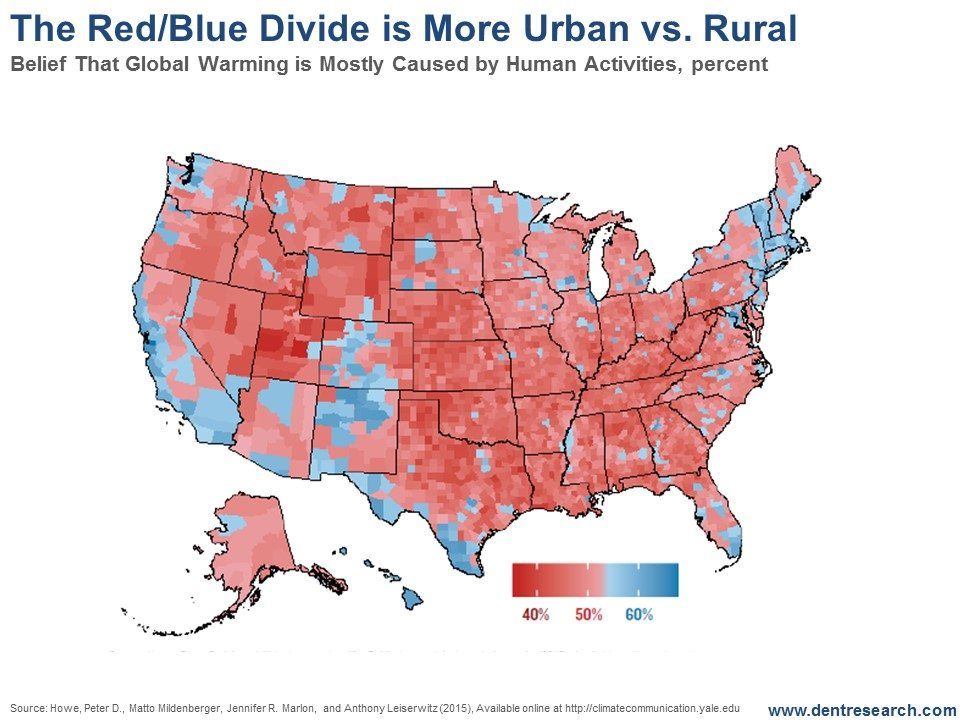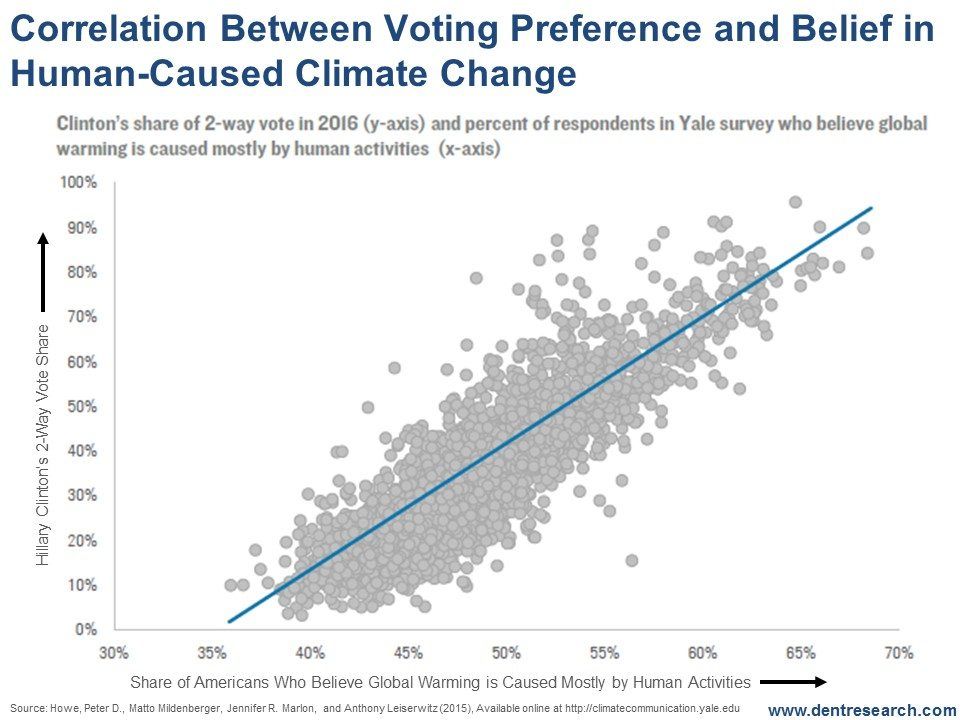I have written many articles on how extremely polarized our politics has become in the last decade. I’ve dedicated several Leading Edge newsletters to the topic. I talked about it at our 2016 Irrational Economic Summit. I even discuss it briefly in my new book, Trump, Brexit, and the Next Civil War, which will be available around mid-August.
I talk about it so much because it’s related to the mega 250-Year Revolution Cycle sweeping over us right now. We’ll feel the effects of this cycle for decades to come… which I detail in my new book.
But today I want to show you another aspect of this divide.
Look at this chart.
There are a number of partisan issues that delineate the differences between red and blue voters, and this is clearly one of them. The chart on red versus blue voting in the last presidential election is nearly identical to this one.
When you look more closely, you can see that the red/blue split in our country is more a rural/urban split. Roughly 20% of our population lives in major cities, 60% in suburbs, and 20% in rural areas. Those closer to the larger cities tend to lean more toward liberal views.
Even in the largest red state – Texas – Dallas and Houston residents tend to be more liberal, although not as liberal as Austin, with Willie Nelson as its mascot.
The rural areas are more conservative. It’s no surprise that states like Nebraska, Kansas, Oklahoma, West Virginia, Kentucky, Tennessee, Wyoming, and Alaska were red states during last year’s election. They have huge swathes of rural land.
This is important because of this…
For the longest time after the election, there was all this debate about why Clinton lost. The truth is that Trump won the rural white vote by margins of 80%-plus… much higher than Clinton won the traditional working class and voters living in the inner-cities.
I saw a show a while back about a rural county in Alabama where Trump got 89% of the vote! The formerly blue states that turned red for Trump, like Pennsylvania, Ohio, Michigan, and Wisconsin have large rural, red areas!
The strong rural red leaning also explains why the Republicans were favored twice by the electoral college. It favors land mass a bit more than voter density – as does the two senators per state, which gives low population rural states like Wyoming more representation.
I’m not taking sides here. I lean red on some issues (more fiscal) and blue on others (more social). But the current split across the country is an unsustainable imbalance. The U.S. is the most politically polarized of the major developed countries, and it has the highest income inequality that just adds fuel to the polarization fire.
These imbalances block upward mobility, which is a fundamental cornerstone of democracy, innovation, and progress, as is the ability to compromise for effective political change.
We have a revolution coming on a convergence of my 250-Year Revolution and Andrew Pancholi’s 84-Year Populist Revolution cycle. America is going to be at the center of this. This revolution will be as big – if not bigger – than the one that brought us democracy, and the Protestant Reformation in Europe before that.
Watch out for the release of my new book. As a loyal subscriber, you’ll have exclusive access before it goes to the general public in 2018.
The content of our articles is based on what we’ve learned as financial journalists. We do not offer personalized investment advice: you should not base investment decisions solely on what you read here. It’s your money and your responsibility. Our track record is based on hypothetical results and may not reflect the same results as actual trades. Likewise, past performance is no guarantee of future returns. Certain investments such as futures, options, and currency trading carry large potential rewards but also large potential risk. Don’t trade in these markets with money you can’t afford to lose. Delray Publishing LLC expressly forbids its writers from having a financial interest in their own securities or commodities recommendations to readers.
Recommended Content
Editors’ Picks
EUR/USD fluctuates near 1.0700 after US data

EUR/USD stays in a consolidation phase at around 1.0700 in the American session on Wednesday. The data from the US showed a strong increase in Durable Goods Orders, supporting the USD and making it difficult for the pair to gain traction.
USD/JPY refreshes 34-year high, attacks 155.00 as intervention risks loom

USD/JPY is renewing a multi-decade high, closing in on 155.00. Traders turn cautious on heightened risks of Japan's FX intervention. Broad US Dollar rebound aids the upside in the major. US Durable Goods data are next on tap.
Gold keeps consolidating ahead of US first-tier figures

Gold finds it difficult to stage a rebound midweek following Monday's sharp decline but manages to hold above $2,300. The benchmark 10-year US Treasury bond yield stays in the green above 4.6% after US data, not allowing the pair to turn north.
Worldcoin looks set for comeback despite Nvidia’s 22% crash Premium

Worldcoin price is in a better position than last week's and shows signs of a potential comeback. This development occurs amid the sharp decline in the valuation of the popular GPU manufacturer Nvidia.
Three fundamentals for the week: US GDP, BoJ and the Fed's favorite inflation gauge stand out Premium

While it is hard to predict when geopolitical news erupts, the level of tension is lower – allowing for key data to have its say. This week's US figures are set to shape the Federal Reserve's decision next week – and the Bank of Japan may struggle to halt the Yen's deterioration.

